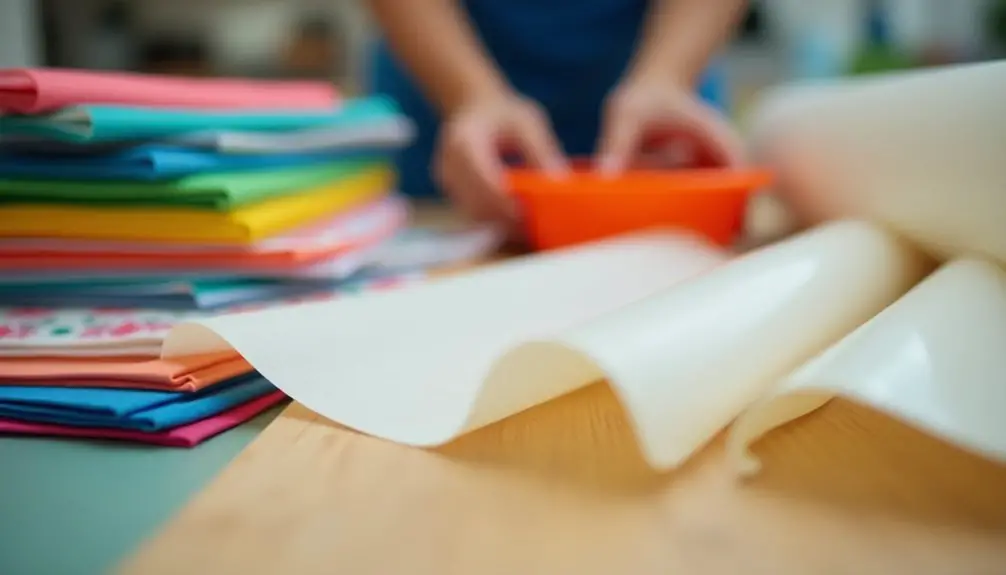To use polypropylene effectively, start by understanding its unique properties. It's lightweight and resistant to moisture, making it great for packaging and textiles. In automotive applications, it enhances safety and fuel efficiency. For best results, adjust heated bed temperatures to 85-100 °C to avoid warping during printing. Always choose the right surface, like packing tape, to ensure good adhesion. If you're in construction, consider its effectiveness in pipes and erosion control. Remember to handle it safely, as it can degrade under UV exposure. Stick around to discover more tips for maximizing polypropylene in your projects!
Key Takeaways
- For packaging, utilize lightweight polypropylene to enhance moisture resistance and reduce shipping costs while ensuring product safety.
- In automotive applications, leverage its high melting point and fatigue resistance for durable components like battery casings and bumpers.
- In medical uses, prioritize non-toxic, biocompatible polypropylene for sterile items such as syringes and sutures to ensure patient safety.
- When working with textiles, choose polypropylene for carpets and upholstery due to its mold and moisture resistance, ensuring longevity.
- For construction, use polypropylene pipes and geotextiles for effective soil stabilization and erosion control, maximizing durability and efficiency.
Common Applications of Polypropylene
Polypropylene's versatility makes it a popular choice across various industries, from packaging to construction. One of the most significant applications is in packaging materials, where its lightweight material and moisture-resistant properties make it ideal. With around 45 metric tons of global demand, it's clear why polypropylene is a staple in packaging applications. Furthermore, polypropylene's use in the medical sector contributes to the 25% of hospital waste generated by plastic materials, emphasizing the importance of sustainable practices in this industry.
In the automotive industry, you'll find polypropylene used for manufacturing components like battery casings, bumpers, and interior trim. Its impact resistance and low density contribute to a safer, more fuel-efficient vehicle.
The medical sector also relies heavily on polypropylene, utilizing it for sterile syringes, IV components, and non-absorbable sutures like Prolene. Its chemical resistance and biocompatibility ensure safety and effectiveness in medical applications.
In textile use, polypropylene shines in carpets, upholstery, and nonwoven fabrics due to its durability and resistance to mold and moisture.
Finally, in the construction industry, polypropylene is employed in pipes, fittings, and geotextiles. Its lightweight characteristics and chemical resistance make it perfect for effective soil stabilization and erosion control.
These diverse applications highlight polypropylene's essential role in modern manufacturing and daily life.
Key Material Properties
When considering materials for various applications, polypropylene stands out due to its impressive properties. This versatile thermoplastic is lightweight, with a density of less than 1 g/ml, making it perfect for weight-sensitive uses like automotive parts and food packaging. Its high melting point of around 160°C ensures that polypropylene maintains its structural integrity even in heat-resistant applications.
One of the key properties of polypropylene is its excellent fatigue resistance, which allows it to withstand repeated bending or flexing. This makes it ideal for products like living hinges and outdoor gear that require durability.
Additionally, polypropylene boasts low moisture absorption, meaning it remains unaffected in damp environments—an essential trait for outdoor and hygienic applications.
Moreover, the chemical resistance of polypropylene protects it from various substances, enhancing its versatility across different industries. Its good insulation properties make it a popular choice in electrical and electronic components, where it effectively isolates and protects sensitive parts. Furthermore, polypropylene's recyclability is a significant advantage over materials like PVC recycling, which have higher chlorine content and complicate the recycling process.
Advantages and Disadvantages

In weighing the pros and cons of using polypropylene, you'll find a material that offers several distinct advantages alongside some notable drawbacks. One significant advantage is its lightweight nature, which makes it ideal for transport and reduces overall product weight in applications like automotive and packaging.
Additionally, polypropylene exhibits excellent chemical resistance, ensuring durability in various environments, particularly in medical devices that require sterilization.
However, there are disadvantages to consider. Polypropylene is susceptible to UV degradation, which can lead to brittleness and a reduced lifespan when exposed to prolonged sunlight. This makes it less suitable for outdoor applications without proper treatment.
Furthermore, while it's a low-cost option, the material has relatively low stiffness compared to engineering plastics like nylon, limiting its use in applications where high rigidity is essential.
Lastly, recycling polypropylene can be a challenge due to its low overall recycling rate, raising concerns about its environmental impact despite its potential for reuse. With proper care and adherence to guidelines, however, polypropylene (PP) can be safely reused for food storage, minimizing waste and supporting sustainability efforts by reducing reliance on single-use plastics.
Safety Considerations
Considering the widespread use of polypropylene in food and medical applications, it's vital to address safety considerations associated with this versatile material. Known for its non-toxic nature, polypropylene is generally safe for packaging consumables. However, it's essential to consider potential risks during the manufacturing process, making it crucial to source products from reputable sources. When using polypropylene, pay attention to its chemical resistance, which prevents harmful substances from leaching into food or medical products. If you're working with high temperatures, remember that polypropylene has a low melting point, which can lead to flammability or deformation. Moreover, the risk of leaching chemicals from polypropylene is far lower compared to plastic kettle alternatives that may contain BPA and other hazardous substances.
| Safety Aspect | Details | Action Required |
|---|---|---|
| Non-toxic Nature | Safe for food and medical use | Choose certified products |
| Chemical Resistance | Prevents harmful leaching | Verify product specifications |
| High Temperatures | Low melting point may cause issues | Avoid overheating |
| Proper Disposal | Burning alters chemical structure | Follow recycling practices |
| Environmental Concerns | Dispose responsibly to minimize impact | Check local guidelines
Best Practices for Use

To get the best results from polypropylene, implementing best practices during use is key. This versatile material, known for its excellent chemical and impact resistance, thrives when handled correctly.
Maintain heated bed temperatures: Set your heated bed to 85-100 °C to minimize warping and improve adhesion.
Choose the right build surface: Use packing tape or a polypropylene sheet to enhance adhesion and prevent excessive sticking.
Utilize a part cooling fan: During printing, employ a fan to ensure better quality prints and prevent layer deformation.
Adjust temperature settings: Start printing at lower temperatures for the initial layers, then gradually increase the temperature for better layer adhesion.
When constructing polypropylene greenhouses, consider using thermal mass materials to regulate temperature fluctuations and maintain optimal growth conditions for plants.
Frequently Asked Questions
What Is a Disadvantage of Polypropylene?
One disadvantage of polypropylene is its low UV resistance; prolonged sunlight exposure can cause it to degrade and become brittle. This makes it less suitable for outdoor applications where durability under harsh conditions is crucial.
How Can You Increase the Impact Strength of Polypropylene?
You can increase polypropylene's impact strength by incorporating elastomeric modifiers, using copolymer instead of homopolymer, raising molecular weight, blending with compatible materials, and optimizing your processing techniques to reduce internal stresses during molding.
What Temperature Should a PP Nozzle Be?
For your polypropylene nozzle, you should set the temperature between 220°C and 250°C. This range ensures proper melting and flow, allowing your prints to adhere well and maintain quality throughout the process.
What Is the Best Glue to Use on Polypropylene?
To bond polypropylene effectively, you'll want to use specialized adhesives like cyanoacrylate or epoxy. For flexibility, consider silicone-based adhesives. Always prepare the surface by cleaning it and lightly abrading for better adhesion.

